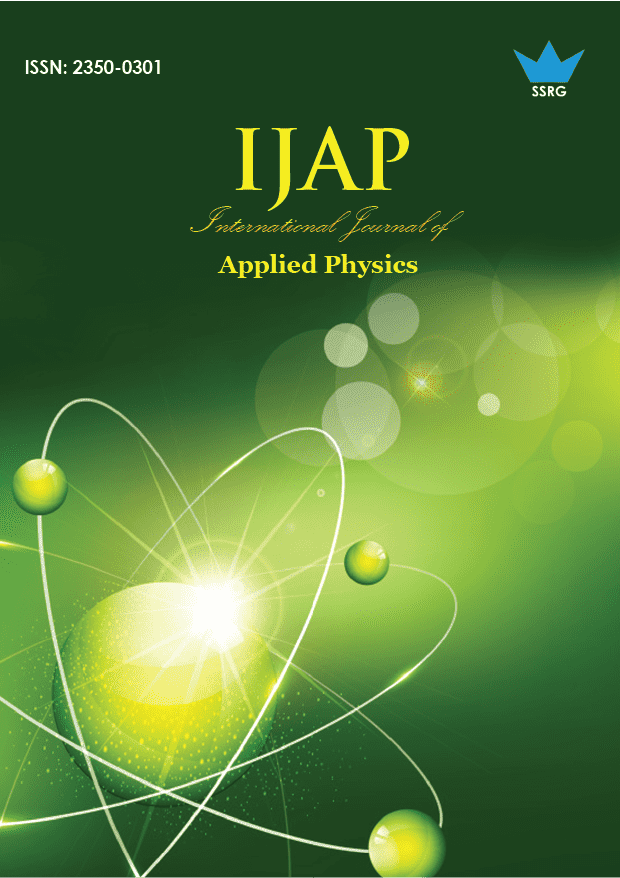Salinity-Induced Stability Transitions of SiO₂ and Al₂O₃ Nanoparticles for Enhanced Oil Recovery Applications

| International Journal of Applied Physics |
| © 2025 by SSRG - IJAP Journal |
| Volume 12 Issue 2 |
| Year of Publication : 2025 |
| Authors : Muhammad Hamza, Musa Momoh, Faruk Sani, and Lawal Sa’ad |
How to Cite?
Muhammad Hamza, Musa Momoh, Faruk Sani, and Lawal Sa’ad, "Salinity-Induced Stability Transitions of SiO₂ and Al₂O₃ Nanoparticles for Enhanced Oil Recovery Applications," SSRG International Journal of Applied Physics, vol. 12, no. 2, pp. 15-24, 2025. Crossref, https://doi.org/10.14445/23500301/IJAP-V12I2P103
Abstract:
In order to assess the behavior of SiO₂ and Al₂O₃ nanoparticles for possible use in enhanced oil recovery (EOR), this study examines their dispersion stability under varying salinity (0.1–2.0 M) and concentration (0.01–3.0 wt%). At 0.1 M ionic strength, SiO₂ nanoparticles showed good stability, especially below 1 wt%, where electrostatic repulsion was maintained (zeta potential: –9.52 to –15.02 mV) and sedimentation was mild. Larger hydrodynamic diameters (up to 895.88 nm) and noticeable sedimentation, particularly at higher concentrations, were the result of ionic charge screening, which caused zeta potentials to decrease as salinity rose to 1.0 M and 2.0 M. These patterns supported a gradual destabilization brought on by a decrease in electrostatic repulsion. However, because of their larger size and intrinsic positive surface charge, Al₂O₃ nanoparticles exhibited different behavior. While increasing concentration at 0.1 M resulted in early aggregation and sedimentation, it improved surface charge (zeta potential: +7.92 to +15.20 mV). Higher ionic strength compressed the electrical double layer at 1.0 and 2.0 M, causing severe aggregation and sedimentation at all concentrations, even though zeta potentials remained high (+12.5 to +21.2 mV). Significantly, this shows that zeta potential alone is not a reliable indicator of stability in high salinity systems. Overall, although both nanoparticles show some dispersion stability at low concentrations (≤0.1 wt%) and salinity, stability decreases with ionic strength due to van der Waals attraction, double-layer compression, and charge screening. Surface modification or salinity control is needed for performance in high-salinity EOR.
Keywords:
Aggregation, Alumina nanoparticles, Enhanced oil recovery, Interfacial tension, Silica nanoparticles.
References:
[1] Anirbid Sircar et al., “Applications of Nanoparticles in Enhanced Oil Recovery,” Petroleum Research, vol. 7, no. 1, pp. 77-90, 2022.
[CrossRef] [Google Scholar] [Publisher Link]
[2] Aly A. Hamouda, and Rockey Abhishek, “Effect of Salinity on Silica Nanoparticle Adsorption Kinetics and Mechanisms for Fluid/Rock Interaction with Calcite,” Nanomaterials, vol. 9, no. 2, pp. 1-15, 2019.
[CrossRef] [Google Scholar] [Publisher Link]
[3] Anthony Hutin et al., “Stability of Silica Nanofluids at High Salinity and High Temperature,” Powders, vol. 2, no. 1, pp. 1-20, 2022.
[CrossRef] [Google Scholar] [Publisher Link]
[4] Elmira Dalabayeva, Peyman Pourafshary, and Rizwan Muneer, “DLVO-Based Prediction of Critical pH for Fines Migration in Sandstone Reservoirs,” Petroleum Research, pp. 1-12, 2025.
[CrossRef] [Google Scholar] [Publisher Link]
[5] Víctor Agmo Hernández, “An Overview of Surface Forces and the DLVO Theory,” ChemTexts, vol. 9, no. 4, pp. 1-16, 2023.
[CrossRef] [Google Scholar] [Publisher Link]
[6] Namsoon Eom, Drew F. Parsons, and Vincent S. J. Craig, “Roughness in Surface Force Measurements: Extension of DLVO Theory to Describe the Forces between Hafnia Surfaces,” Journal of Physical Chemistry B, vol. 121, no. 26, pp. 6442-6453, 2017.
[CrossRef] [Google Scholar] [Publisher Link]
[7] Osamah Alomair et al., “Evaluation of the Coupled Impact of Silicon Oxide Nanoparticles and Low-Salinity Water on the Wettability Alteration of Berea Sandstones,” Petroleum Exploration and Development, vol. 50, no. 4, pp. 934-943, 2023. [CrossRef] [Google Scholar] [Publisher Link]
[8] Omid Tavakkoli et al., “SDS-Aluminum Oxide Nanofluid for Enhanced Oil Recovery: IFT, Adsorption, and Oil Displacement Efficiency,” ACS Omega, vol. 7, no. 16, pp. 14022-14030, 2022.
[CrossRef] [Google Scholar] [Publisher Link]
[9] Talha Majeed et al., “A Review on Foam Stabilizers for Enhanced Oil Recovery,” American Chemical Society, vol. 35, no. 7, pp. 5594-5612, 2021.
[CrossRef] [Google Scholar] [Publisher Link]
[10] Paulo Siani et al., “Modeling Zeta Potential for Nanoparticles in Solution: Water Flexibility Matters,” Journal of Physical Chemistry C, vol. 127, no. 19, pp. 9236-9247, 2023.
[CrossRef] [Google Scholar] [Publisher Link]
[11] Zeta Potential-Introduction 30min Malvern, 2015. [Online]. Available: https://www.research.colostate.edu/wp-content/uploads/2018/11/ZetaPotential-Introduction-in-30min-Malvern.pdf
[12] Jianxiang Huang, Damiano Buratto, and Ruhong Zhou, “Probing the Electrostatic Aggregation of Nanoparticles with Oppositely Charged Molecular Ions,” Aggregate, vol. 4, no. 4, pp. 1-10, 2023.
[CrossRef] [Google Scholar] [Publisher Link]
[13] Ali Mohammad Makbul Tamboli, and Julekha Munaf Tade, “Zeta Potential: A Comprehensive Review,” International Research Journal of Pharmacy and Medical Sciences, vol. 8, no. 2, pp. 115-124, 2025.
[Google Scholar] [Publisher Link]
[14] Dieter Rahmadiawan, and Shih-Chen Shi, “Enhanced Stability, Superior Anti-Corrosive, and Tribological Performance of Al2O3 Water-based Nanofluid Lubricants with Tannic Acid and Carboxymethyl Cellulose over SDBS as Surfactant,” Scientific Reports, vol. 14, no. 1, pp. 1-13, 2024.
[CrossRef] [Google Scholar] [Publisher Link]
[15] Pavlo Pinchuk, and Ke Jiang, “Size-Dependent Hamaker Constants for Silver and Gold Nanoparticles,” Physical Chemistry of Interfaces and Nanomaterials XIV, vol. 9549, 2015.
[CrossRef] [Google Scholar] [Publisher Link]
[16] Zafar Said et al., “Recent Advances on the Fundamental Physical Phenomena Behind Stability, Dynamic Motion, Thermophysical Properties, Heat Transport, Applications, and Challenges of Nanofluids,” Physics Reports, vol. 946, pp. 1-94, 2022.
[CrossRef] [Google Scholar] [Publisher Link]

 10.14445/23500301/IJAP-V12I2P103
10.14445/23500301/IJAP-V12I2P103